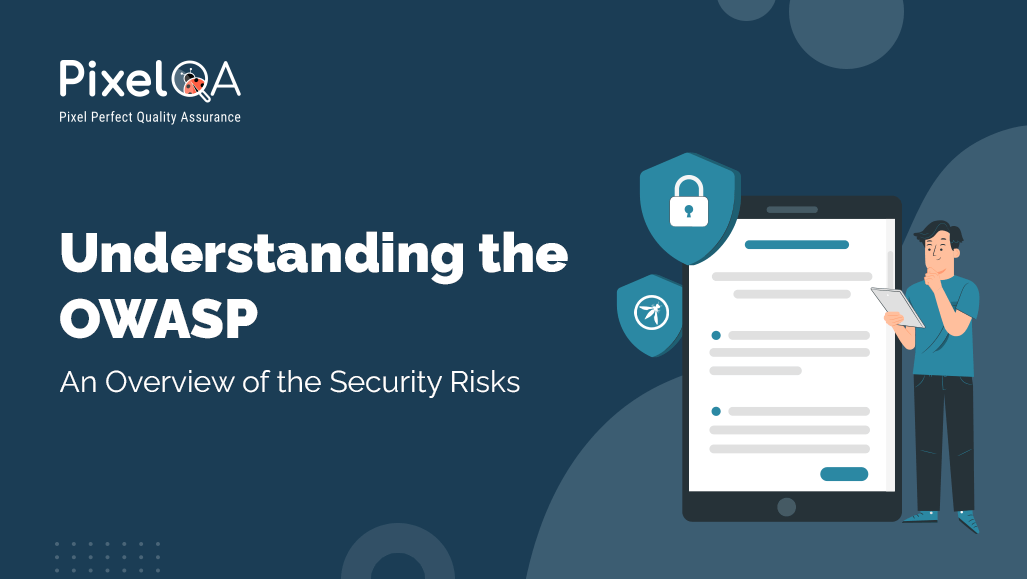
Introduction:
Web applications play a vital role in almost all businesses and daily undertakings in the computerized world of today, but they pose significant security threats. The Open Web Application Security Project (OWASP) provides useful guidance through its OWASP Top 10, which categorizes the most basic vulnerabilities facing web applications. It is upon the engineers, security professionals, and enterprises holding sensitive information and striving to keep customer trust to know these threats. Organizations can use security testing services to tackle such issues and help strengthen their defenses. This diagram illustrates the OWASP common threats and the significance of preventively securing such vulnerabilities, as well as good practices helpful in curbing them. By knowing these threats, we can better protect our applications and ensure a more secure web experience.
Table of Contents
- OWASP Top 10 Vulnerabilities for ‘Web’
- OWASP Top 10 Vulnerabilities for ‘Mobile APK’
- OWASP Top 10 Vulnerabilities for ‘API’
- OWASP Top 10 Vulnerabilities for ‘IoT’
- Conclusion
OWASP Top 10 Vulnerabilities for ‘Web’
We are living in the internet world where web applications have become omnipresent, from account opening and shopping to social networking. But with all this, we are opening doors to the security vulnerabilities that can harm customers and enterprises. The OWASP Top 10 lists the most severe threat categories for online projects. Let us find out why these vulnerabilities need to be considered for the safety of our internet behavior.
1. Broken Access Control: An insecure direct object reference occurs when an application fails to adequately enforce permissions for a user to access resources meant for others. An unauthorized user can access sensitive data or an admin function without the required permission.
2. Cryptographic Failures: This is also known as "Sensitive Data Exposure," and deals with problems with improper handling of sensitive data. Sensitive data is not well protected, and it also causes problems with encryption and improper data management, all of which can result in data breaches.
3. Injection Flaws: These take place when a program executes untrusted data as a command or query after acknowledging it. For example, SQL injection gives hackers the ability to change or expose data by manipulating database queries.
4. Insecure Design: This vulnerability is the result of an application's design phase not taking security into account. It may result in basic flaws that are challenging to fix, including improperly applied security measures.
5. Security Misconfiguration: This occurs when a program or any of its components are not set securely, making them open to intrusions. Unnecessary services enabled, default settings left unmodified, incorrect file and directory permissions are a few examples.
6. Vulnerable and Outdated Components: Outdated or insufficiently supported libraries and frameworks may expose applications to known security vulnerabilities. Therefore, regular updates and maintenance of these components are crucial to minimize possible threats.
7. Identification and Authentication Failures: This vulnerability includes flaws in the user identification and verification processes. It can involve problems like weak password arrangements, poor session management, or improper use of multi-factor authentication.
8. Software and Data Integrity Failures: Vulnerabilities affecting the integrity of data and software fall under this category. Inappropriate software update validation or the use of doubtful data storage techniques that could be used to manipulate information are two examples.
9. Security Logging and Monitoring Failures: It is difficult to identify and respond to security issues without sufficient recording and observation. This vulnerability addresses the requirement for insufficient monitoring systems and sufficient logging of security-relevant events.
10. Server-Side Request Forgery (SSRF): A hacker can take advantage of SSRF vulnerabilities when they can fool a server into processing requests whenever they like. Unauthorized access to internal services or data could arise from this, circumventing firewalls and other security precautions.
OWASP Top 10 Vulnerabilities for ‘Mobile APK’
The most serious security holes in mobile apps security testing are listed here. This assists developers and security specialists in finding and fixing common vulnerabilities to protect mobile apps from hackers, just like the OWASP top 10 Web applications.
- Improper Platform Usage:Issues with inappropriate usage of platform APIs or lack of protection for sensitive data are examples of insecure mobile platform feature exploitation.
- Insecure Data Storage: Issues arise when private data is kept on the device in an unsecured manner, leaving it open to unwanted access.
- Insecure Communication: This puts data interception at risk by using poor or insufficient encryption for data transferred between the app and servers.
- Insecure Authentication: Unauthorized access may result from weaknesses in an app's user login and session management, such as weak password rules or incorrect session handling.
- Insufficient Cryptography: Using old or inadequate encryption techniques exposes private information to hackers.
- Insecure Code: This includes potentially exploitable flaws in the app's source code, like hardcoded secrets or poor coding techniques.
- Code Injection: When an app permits untrusted data to be run as code, problems can occur that could result in harmful behavior.
- Reverse Engineering: In the event that the app's code is considered to contain fairly low barriers to accessibility, the reverse engineer could identify certain vulnerabilities existent within the app and exploit such vulnerabilities.
- Extraneous Functionality: Features or functionalities of apps poorly protected would primarily be weaponized by someone who is not the intended user.
- Poor App Security Configuration: Vulnerabilities may arise from incorrect settings or security control sets in the app.
OWASP Top 10 Vulnerabilities for ‘API’
Some crucial vulnerabilities with regard to APIs listed under OWASP include broken authorization, insufficient authentication, and excessive data exposure, which could lead to either unauthorized access or data leakage. Other threats include insufficient rate limiting, insecure configuration, injection attacks, improper asset management, and insufficient logging. Addressing these vulnerabilities through API security testing is essential for ensuring API security and protecting sensitive information.
- Broken Object Level Authorization: This happens when weak authorization verification in APIs allow users to view data that they shouldn't be able to see, including another user's data.
- Broken User Authentication: An API can allow attackers to take on users if it fails to properly verify user IDs. Session management issues or poor password Policies may be responsible for this.
- Excessive Data Exposure: Occasionally, APIs return more data than is required. It can be used against you if the response contains sensitive information.
- Lack of Resources & Rate Limiting: If there's no restrictions on the number of requests to an API, they may become too numerous. Exploitation or a denial of service may result from this.
- Broken Function Level Authorization: Similar to object-level authorization, this one focuses on granting access to features. It's quite dangerous if people have unauthorized access to admin services.
- Mass Assignment: When users can alter numerous fields through APIs without the necessary validation, this happens. Attackers can change user roles or other fields to which they shouldn't have access.
- Security Misconfiguration: APIs that are not properly configured may expose private data or services. Using the default settings or leaving on features that aren't needed are examples of this.
- Injection Flaws: Like standard web programs, APIs can be subject to injection attacks like SQL or NoSQL injections if input isn't adequately cleaned.
- Improper Assets Management: When older or less secure APIs are kept open, improper management of the development, testing, and production environments which are frequently present in APIs can result in security problems.
- Insufficient Logging & Monitoring: It is difficult to identify or address security vulnerabilities without proper logging. To detect attacks, APIs must monitor behaviors and irregularities.
OWASP Top 10 Vulnerabilities for ‘IoT’
- Weak, Guessable, or Hardcoded Passwords:Some Web of Things devices have default or hardcoded passwords that are easy to decipher, leaving them vulnerable to unwanted access.
- Insecure Network Services: IoT devices often reveal unnecessary services or interfaces that, if not properly secured, could then be abused.
- Insufficient Privacy Protection: Numerous Internet of Things devices risk customer security by collecting personal data without providing adequate assurance or consent.
- Insecure Software/Firmware: Devices may have out-of-date software or require valid repair tools, leaving them vulnerable to known flaws.
- Insecure Cloud Interfaces: Unreliable APIs may reveal information and value to attackers if IoT devices rely on cloud services.
- Lack of Device Management: Vulnerabilities can result from careless device management, including inadequate authentication and authorization.
- Insufficient Security Configurability: Customers frequently lack the ability to customize security settings, which leaves devices vulnerable to theft.
- Physical Attacks: Many IoT devices are easily physically accessible, allowing attackers to manipulate or remove sensitive data.
- Insecure Data Transfer and Storage: Information might not be mixed while moving or at rest, making it vulnerable to illegal access or capture efforts.
- Lack of Secure Update Mechanisms: Vulnerabilities are difficult to resolve since devices require a secure firmware upgrade plan on a regular basis.
Conclusion
More than being just a challenge, identifying and solving such problems in the digital arena is what the OWASP Top 10 visually presents in regard to vulnerabilities such as failed access control and injection able to undermine the application and endanger its users' data. Tools such as OWASP ZAP and Burp Suite enable developers to seek out these threats and mitigate them. Prioritizing security awareness and conducting regular assessments can lead to the creation of even more secure applications that would shield users and organizations from online threats.
About Author

Rushi Mistry is a Security Tester at PixelQA a Software Testing Company with a focus on cybersecurity. He is passionate about IoT penetration testing and is working towards obtaining a CISSP certification, with the ultimate goal of becoming a Chief Information Security Officer (CISO).



